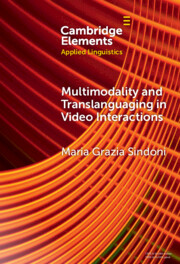Element contents
Multimodality and Translanguaging in Video Interactions
Published online by Cambridge University Press: 28 November 2023
Summary
Keywords
- Type
- Element
- Information
- Series: Elements in Applied LinguisticsOnline ISBN: 9781009286947Publisher: Cambridge University PressPrint publication: 21 December 2023
References
- 2
- Cited by



